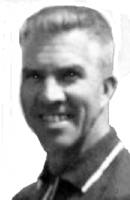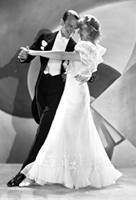
|
Folk Dance Federation of California, South, Inc.
|

|
CLICK AN IMAGE TO ENLARGE
 It is my belief that as we dance we are concerned with efficient and good use of the body.
It is my belief that as we dance we are concerned with efficient and good use of the body.
Factors that influence movement, such as
law of gravitation
law of attraction and repulsion
law of resistance and yielding
should be related to human movement as dance skills are analyzed.
In addition, I believe that movement should be natural to the individual and not an imitation. Movements should have sequential action in which one movement flows into the other.
Especially in dance, if the mechanics of moving are right for the individual, then the doing will "feel rightd" and real enjoyment and satisfaction will result.
Instead of memorizing as series of step patterns in social dance – especially for the beginner – I believe in allowing the individual to explore differencent kinds of movement patterns and then relate and compose these movements into popular ballroom dance forms.
There is, however, certain basic information necessary that may assist each person to "get the most out of his dancing."
This information might be organized in the following way:
- TIMING and QUALITIES in MUSIC –
How does a Waltz differ from a Fox Trot?
How does Rumba music differ from Tango and other Latin music?
How does the music determine HOW and WHAT dance should be done? - BASIC STEPS and some pouplar VARIATIONS –
How can I move from one step to another?
How can I get from a right turn to a left turn?
How can I do more variations? (I get tired doing the same step over and over.)
How can I feel more at ease and comfortable while dancing? - LEADING and FOLLOWING –
What are certain basic techniques to leading and following? Which are essential to good dancing?
Realize, of course, that the TIME factor in number 1 influences the SPACE factor in number 2.
Ballroom dance includes: Cha Cha, Fox Trot, Mambo, Rumba, Tango, Samba, Swing (Rock 'n' Roll), and Waltz.
When You Hear the Dance Music
Listen for the pulse beats, they will be even and steady.
Listen to the accented beats, they will occur at certain intervals and are louder than the other pulse beats.
Walk on each pulse beat and take a bigger step on the accented beat.
If every other beat is accented then you would count 1 2 1 2 1 2.
If ever third beat is accented then you would count 1 2 3 1 2 3.
If every fourth beat is accented then you would count 1 2 3 4 1 2 3 4.
When you step on every pulse beat you are walking, as the steps would be steady and even.
To give variety to this "one step," dancers often hold a step for two pulse beats making that step slower.
Leading
The man must know what he is going to do and where he is going.
He usually leads off with his left foot.
He primarily uses his right hand (finger tips to the spine under the woman's shoulder blade) to turn his partner into different dance positions.
Additional lead is given with the right arm which should be held up contacting and supporting his partner's left arm.
His left arm should be held comfortably up to the side – almost straight.
He makes individual adjustments when necessary.
Following
The woman must be aware of which foot the man has free, and in which direction he is going to move.
The woman should be ready do reach back with the toe and take a long step backward.
"Ladies" – By all means DON'T LEAD YOUR PARTNER.
Dance Positions
There are many different dance positions with a variety of names.
Most common are:
- CLOSED DANCE POSITION: partners face each other.
- OPEN DANCE POSITION: partners stand side by side facing the same direction.
- SIDE REVERSE POSITION: partners stand side by side, but facing opposite directions.
In some dances, partners just holds one or both hands.
These are given other names but for simplicity and for beginners, this is enough!
Suggestion
Notate steps as you learn them with whatever method is most meaningful to you.
This can help you remember the steps, but more importantly, it will help you to understand what you are doing.
Remember
Ballroom dance is done with a partner for entertainment and enjoyment.
It should interpret the music as to rhythm and style.
There is no absolute "right or wrong" – it is a matter of what works best for you.
Printed in the Santa Barbara Fifth Annual Folk Dance Conference Syllabus, 1960.